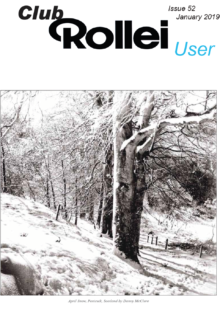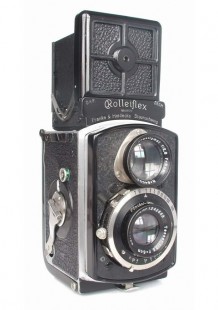This winter has been a mixed bag weatherwise, nothing to entice me out with a camera, although the total eclipse of the super blood wolf moon on 21st January was an event which was too good to miss. I confess I used my Olympus Stylus 1, a digital bridge camera which is a compact SLR with digital viewfinder. Especially useful in circumstances like this with an exposure of 1/2 second at f2.8, it has image stabilisation and a zoom range equivalent to that of a 35mm camera of 28 - 300mm.

seen from Chichester, 5am 21st January 2019
The image size for solar/lunar photographs is approximately 1mm diameter on film per 100mm of focal length. So a 1000mm focal length will equate to 10mm image size. This is irrespective of film format. The image size here is not large but has enlarged sufficiently for the cropped photo on the right. Full frame shows the surrounding stars. In the days before I realised the errors of my ways I traded my Rolleicord Vb for a Polaroid SX70 and then moved to a Pentax 110 miniature SLR to take with me on a safari trip to Kenya - telephoto lens was f2.8 50mm (I hear sniggering in the background) to capture wild life photos.
Just by chance (several years ago), some guests in the hotel foyer were talking about a total solar eclipse the following morning, centered about three hours drive away. A coach had been organised to take interested guests to the location, leaving at 6am. I was innocently ignorant as to the magnification factor mentioned above and thought my 50mm lens would be ideal. As needs must, I had a pair of Polaroid sunglasses and by removing the lenses, I could rotate one 90° to the other to reduce the brightness to virtually zero. At full eclipse, this is not really necessary.
Arriving at the site, there were many people with 'proper' cameras. On enquiring as to what lenses they were using, most had 1000mm with a 2x converter or 500mm with two 2x converters. Being inexperienced, I thought my 50mm 'telephoto' would be OK. As the total eclipse neared, the world went dark and totally silent; all wildlife sounds ceased as if it was night time. NASA, who had built a launch site a couple of miles away,fired their rocket towards the sun. The only sounds were the clicking of shutters and gasps of amazement. It lasted about two minutes before the world woke up again and carried on as if nothing had happened. I have the T-shirt to prove I was there!
I needed a magnifying glass to make out the eclipse on the returned 6x4 inch prints. I vowed to get a better camera on my return home. My next foray into total eclipses was at Salcombe in south Devon on 11th August 1999. Having booked accommodation a year in advance, at greatly inflated cost, and bought a 500mm lens and two 2x converters for my Rolleiflex 3003, the sky was completely overcast and it was cold and windy. No photographs that day but the world still went dark and totally quiet for two minutes. A wonderful experience none the less.
Contents:
Front Cover: April Snow, Penicuik by Danny McClure.
- 3 In Passing by David Morgan
- 4 Life of a wedding Photographer by Steve Barham.
- 7 Club Postal Auction results.
- 8 Old Glass Photographic Plates by John Wild.
- 11 Ektachrome relaunch by David Morgan.
- 12 Under the Rainbow by Dáithí ó Scannláin.
- 15 Rollei 35's by Steve Barham and One Instant peel apart instant film
- 16 Along the River Dove by Tony Wood
- 21 Dufaycolor by David Morgan.
- 24 Shirley Wellard by John Wild.
- 26 Rolleimarin Display Tripod by Wulf H. Koehler
- 28 My Rolleiflex New Standard by David Beake
- 31 6000 Series Batteries
Rear Cover: São Miguel, Azores, photos by John Wild.

